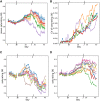Escherichia coli with a Tunable Point Mutation Rate for Evolution Experiments
- PMID: 32503807
- PMCID: PMC7407472
- DOI: 10.1534/g3.120.401124
Escherichia coli with a Tunable Point Mutation Rate for Evolution Experiments
Abstract
The mutation rate and mutations' effects on fitness are crucial to evolution. Mutation rates are under selection due to linkage between mutation rate modifiers and mutations' effects on fitness. The linkage between a higher mutation rate and more beneficial mutations selects for higher mutation rates, while the linkage between a higher mutation rate and more deleterious mutations selects for lower mutation rates. The net direction of selection on mutations rates depends on the fitness landscape, and a great deal of work has elucidated the fitness landscapes of mutations. However, tests of the effect of varying a mutation rate on evolution in a single organism in a single environment have been difficult. This has been studied using strains of antimutators and mutators, but these strains may differ in additional ways and typically do not allow for continuous variation of the mutation rate. To help investigate the effects of the mutation rate on evolution, we have genetically engineered a strain of Escherichia coli with a point mutation rate that can be smoothly varied over two orders of magnitude. We did this by engineering a strain with inducible control of the mismatch repair proteins MutH and MutL. We used this strain in an approximately 350 generation evolution experiment with controlled variation of the mutation rate. We confirmed the construct and the mutation rate were stable over this time. Sequencing evolved strains revealed a higher number of single nucleotide polymorphisms at higher mutations rates, likely due to either the beneficial effects of these mutations or their linkage to beneficial mutations.
Keywords: Experimental Evolution; Mismatch Repair.
Copyright © 2020 Sherer et al.
Figures







Similar articles
-
Sexual recombination and increased mutation rate expedite evolution of Escherichia coli in varied fitness landscapes.Nat Commun. 2017 Dec 13;8(1):2112. doi: 10.1038/s41467-017-02323-4. Nat Commun. 2017. PMID: 29235478 Free PMC article.
-
Mutation accumulation and fitness in mutator subpopulations of Escherichia coli.Biol Lett. 2012 Dec 5;9(1):20120961. doi: 10.1098/rsbl.2012.0961. Print 2013 Feb 23. Biol Lett. 2012. PMID: 23221876 Free PMC article.
-
Transcriptional Potential Determines the Adaptability of Escherichia coli Strains with Different Fitness Backgrounds.Microbiol Spectr. 2022 Dec 21;10(6):e0252822. doi: 10.1128/spectrum.02528-22. Epub 2022 Nov 29. Microbiol Spectr. 2022. PMID: 36445144 Free PMC article.
-
Evolution of global regulatory networks during a long-term experiment with Escherichia coli.Bioessays. 2007 Sep;29(9):846-60. doi: 10.1002/bies.20629. Bioessays. 2007. PMID: 17691099 Review.
-
Mutators Enhance Adaptive Micro-Evolution in Pathogenic Microbes.Microorganisms. 2022 Feb 15;10(2):442. doi: 10.3390/microorganisms10020442. Microorganisms. 2022. PMID: 35208897 Free PMC article. Review.
Cited by
-
Incorporating antagonistic pleiotropy into models for molecular replicators.Biosystems. 2021 Mar;201:104333. doi: 10.1016/j.biosystems.2020.104333. Epub 2020 Dec 25. Biosystems. 2021. PMID: 33359635 Free PMC article.
-
The mutational landscape of Bacillus subtilis conditional hypermutators shows how proofreading skews DNA polymerase error rates.Nucleic Acids Res. 2025 Feb 27;53(5):gkaf147. doi: 10.1093/nar/gkaf147. Nucleic Acids Res. 2025. PMID: 40057377 Free PMC article.
-
Open-endedness in synthetic biology: A route to continual innovation for biological design.Sci Adv. 2024 Jan 19;10(3):eadi3621. doi: 10.1126/sciadv.adi3621. Epub 2024 Jan 19. Sci Adv. 2024. PMID: 38241375 Free PMC article. Review.
-
The effect of weak clonal interference on average fitness trajectories in the presence of macroscopic epistasis.Genetics. 2022 Apr 4;220(4):iyac028. doi: 10.1093/genetics/iyac028. Genetics. 2022. PMID: 35171996 Free PMC article.
References
-
- Chou H. H., and Keasling J. D., 2013. Programming adaptive control to evolve increased metabolite production. Nat. Commun. 4: 2595. - PubMed
